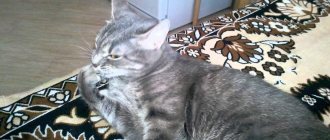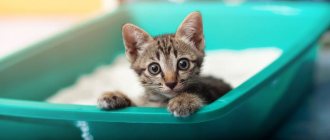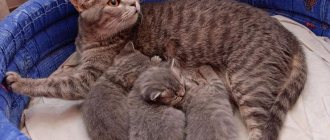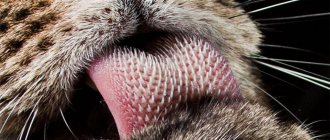Cats are active and very playful animals. Of course, there are extremely lazy individuals, whose most “outstanding” achievement is constant sleep and continuous eating, but still not a single healthy cat will refuse to run properly. Sometimes animals flirt in such a way that they do not behave quite “appropriately”.
And it happens that at this moment short-term convulsions develop: in a cat they often last a couple of seconds, which is why the owners do not have time to understand anything. Meanwhile, any convulsions and seizures, even if they last no more than a couple of seconds, are an extremely bad sign, indicating pathologies that are dangerous to the health and life of the animal.
What are cramps
The first thing all owners of “convulsive” animals need to know is that seizures and other seizures are not a disease in themselves, but they indicate pathological functioning of the brain or the nervous and muscular systems as a whole.
Note that convulsions most often begin in two opposite situations: either the cat is absolutely calm before it, or it is actively moving. It is almost impossible to predict their occurrence.
Characteristic symptoms
The symptoms of a seizure caused by involuntary muscle contraction are quite pronounced, so it is difficult to miss them. The animal is frightened, feeling severe pain, begins to scream loudly, shows aggression, not allowing itself to be touched. During a convulsion, the pet’s pupils are dilated, the whiskers puff up, or, on the contrary, are pressed against the muzzle.
Other signs of seizures in a cat include:
- salivation;
- secretion of foam from the oral cavity;
- involuntary act of defecation;
- uncontrolled urination;
- aggression;
- lack of response to the owner's calls.
Types of seizures
Regardless of the cause, all seizures can be divided into two large categories: local and generalized (generalized). Let's consider these options in more detail.
Generalized seizures
They are easiest to identify even for the most inexperienced owner: in such cases the cat can simply fall, shaking all its limbs, it is clear that the animal is in a semi-conscious state. In many cases, severe tremor of the facial muscles is observed, drooling profusely, and involuntary urination and defecation are observed.
As a rule, generalized convulsions rarely last more than three minutes. More precisely, cats rarely survive longer attacks. In many diseases (more precisely, in their first stages), soon after convulsions the animal fully recovers and often behaves as if nothing had happened. Rapid breathing will indicate what has happened.
Interesting! Such signs indicate severe brain damage - your pet may indeed not remember the seizures, since at that time she was in a state of “twilight consciousness.”
In other cases, immediately after an attack, the animal looks confused, depressed, and may behave inappropriately for some time. During this period, it is very desirable to provide the pet with complete peace and absence of stress, since any negative environmental factors can provoke a repeat attack.
Local convulsions
They are more typical for cats (if we compare them with dogs). Seizures in this case can be very difficult to detect. The problem is that not in all cases the cat’s hind legs (or forelimbs) actively twitch. Everything is much more complicated.
As in the previous case, cats may experience a sharp increase in salivation, foam at the mouth, twitching of the eyelids or facial muscles, excessive vocalization (the cat constantly and loudly screams), as well as strange and abnormal movements of the head and/or limbs.
In severe illnesses, seizures gradually progress to generalized ones, but situations are more common when their frequency and duration increase (first the front legs twitch, and then all the limbs).
Important advice: if you see that something is definitely wrong with your cat, it is very advisable to record this moment on video.
Let us note that even experienced veterinarians are not always able to determine the root cause of seizures if the appearance of the latter is caused by some difficult to diagnose pathologies of the nervous system. In such situations, encephalography is vital. This technique (expensive and rarely used in veterinary medicine) helps to accurately determine the state of the animal's brain.
But! It happens that seizures are not a sign of some serious pathology. Let's give a simple example. Cats, of course, cannot be considered avid swimmers, but sometimes they have to be washed, or the animal ends up in a deep puddle. Local “twitching” after bathing is a relatively normal phenomenon. This happens even to professional swimmers. Treated with peace and rest.
Primary and secondary seizures
Other veterinarians prefer to divide seizures differently: also into two types, but they are guided by the root cause and time of their occurrence. In this case, all seizures are divided into primary and secondary.
The latter are found much more often than the primary ones in veterinary practice. Simply put, secondary seizures are a consequence of some serious illness acquired by the cat during its life. These include: brain tumors, inflammation or infections (encephalitis), consequences of injuries, strokes (yes, they happen in animals too). Secondary status is indicated by the presence of other signs of the disease, such as vomiting, diarrhea, an increase or sharp decrease in body temperature, etc.
With primary seizures, they are also not the disease itself, but indicate severe functional disorders of nervous activity. In particular, persistent and unexplained seizures (which are not, however, epileptic) may indicate an imbalance between the number of “excited” and “inhibited” neurons in the brain, or some problems with the volume of neurotransmitters produced by the body.
In such cases, the first seizures are observed from an early age. However, such animals usually do not live to a relatively mature age. It is believed that no more than 29% are primary. As a rule, all diseases that cause their appearance are genetically determined and are not always diagnosed (due to the lack of appropriate technical equipment).
What temperature is considered critical?
The critical level is 37C and 40.5C. This temperature is a clear sign of illness and problems in the animal. But what signs accompany all this? The simple method of touching the nose will not help because it is false.
Symptoms of elevated temperature:
- Refusal of food and water.
- The pulse rises to 200 beats per minute. The norm is 150 beats per minute.
- The mucous membranes become inflamed.
- He hides and sleeps longer than usual.
- Vomiting or loose stools are common.
- In the worst cases, the animal begins to become exhausted.
Symptoms of low temperature:
- Lethargy and weakness are noticed, the cat begins to tremble due to fever.
- Sleeps more than usual, begins to hide in warm places and refuses to leave them.
- The wool stands on end to further retain heat.
- Heart rate and breathing slow down.
Kitty
Causes of seizures in cats
The causes of seizures in cats are extremely varied and numerous, and therefore it is unrealistic to describe them in one article. They can be caused by both the most “extravagant” and rare degenerative pathologies of the brain, as well as more “mundane” causes (like poisoning).
Let us list the predisposing factors that practicing veterinarians most often have to deal with:
- Seizures are very characteristic of epilepsy , but with this disease they do not develop in 100% of cases.
- They are also frequent manifestations of poisoning. In particular, if strychnine enters a cat’s body, convulsions can be triggered even by birdsong (hyperexcitability of the nervous system).
- Oncological diseases (a common cause of seizures in an old cat).
- Lack of vitamin B1. Often found in cats. The reason is excessive feeding of pets with raw river fish. The fact is that this product contains a large amount of thiaminase. This is an enzyme that destroys B1. Considering that this vitamin is extremely important for the functioning of the central nervous system, the occurrence of seizures in such situations is not surprising.
- Cramps in general are often associated with nutrition. So, if a cat’s body does not receive the proper amount of vitamin B6 and magnesium, nothing good should be expected.
- Very often, seizures develop with renal failure . The reason is a drop in the level of free calcium in the blood serum. In such cases, the normal conduction of neuromuscular impulses is disrupted, which leads to uncontrolled contractions of muscle fibers.
- Allergic reactions. In particular, after vaccination (due to intolerance to the components of the drug).
- Hypertension (and in some cases also hypotension). Critically high or low blood pressure does not have the best effect on brain function.
- Reaction to some medications. In particular, convulsions after anesthesia can hardly be called an absolutely normal phenomenon, but it still happens quite often.
- Sudden temperature changes. In particular, cats have a very (!) hard time withstanding heat and stuffiness.
- Diabetes . One of its characteristic signs is precisely seizures that develop when blood sugar levels drop to a critically low level.
- Problems with the endocrine glands. Thus, pathologies of the thyroid gland can lead to too low levels of calcium in the blood. The result is tetanic convulsions. During estrus or immediately after childbirth, the likelihood of such attacks increases markedly.
Let's describe some of these reasons in a little more detail.
Causes of carbuncle
The appearance of a carbuncle is preceded by an inflammatory process in the soft tissues, which usually begins with an inflammatory disease of the hair follicle - staphylococcal folliculitis, less often - with streptococcal folliculitis.
The development of inflammation can lead to the formation of a boil, which is an acute purulent-necrotic inflammation of the hair follicle. When several such boils form in one area of the body, they can merge with each other.
The product of the merger of several boils is a carbuncle. A sharp bursting pain occurs in the area of infiltration. The skin over the infiltrate becomes purple, tense, and swollen. Large amounts of gray-green pus are released from the pustules.
The tissues become necrotic. There are clear signs of general intoxication: tachycardia, nausea, vomiting, severe headache, hyperthermia up to 39-40 ° C, leukocytosis, shift of the blood count to the left, lack of appetite, insomnia. If the carbuncle is localized on the face, the symptoms of intoxication are much more pronounced, even to the point of fainting.
After exfoliation of necrotic tissue and removal of pus, the severity of signs of intoxication weakens significantly.
Risk factors for carbuncle formation:
- the presence of a chronic source of infection in the body;
- lack of vitamins;
- diabetes mellitus and other metabolic disorders;
- exhaustion of the body;
- psychological overload;
- immunodeficiency states;
- recent operations or serious illnesses;
- skin contamination, poor sanitary culture;
- nutritional deficiency;
- obesity;
- prolonged friction of the skin with clothing;
- increased sweating.
Carbuncle mainly affects teenagers and young adults. Men get sick more often than women.
Convulsions during poisoning
As mentioned above, in case of poisoning, convulsions are a completely “normal” phenomenon. Of course, this is not always the case: such seizures are caused only by toxins that are part of the “convulsive” group. Note that in such cases, everything is usually in order with the animal’s nervous system. If you manage to remove the poison from your pet’s body in time and relieve convulsive seizures, there is a high chance of saving not only the life, but also the health of the cat.
It should be remembered that in case of poisoning, the intensity and duration of convulsions are sharply reduced immediately after gastric lavage or administration of blood substitute fluids (i.e., when the concentration of the toxin in the body decreases).
The most dangerous poisons that can cause such seizures are:
- Strychnine.
- Cicutotoxin.
- Bicycloorthophosphates.
- Silatranes.
- Cis-5,6-dichloro-2,2-dicyano-3,3-bis(trifluoromethyl)norbornane.
- Triazadisulfonoadamantane.
All of them are not very common, but seizures, the appearance of which is caused by poisoning, are quite common.
Why does this happen? The thing is that the same salts of heavy metals, destructive for all mammals, cannot cause seizures by themselves. But they can kill the liver, as a result of which the animal’s blood is literally “overwhelmed” by a stream of toxins. The latter, when they enter the blood, cause various and very severe side effects. They often cause chronic renal failure later, and we already know that kidney failure leads to problems with calcium levels in the blood...
What should the owner do if the cat is itching and licking?
Owners are usually alarmed if a domestic cat frequently licks and scratches itself. And such problems must be resolved immediately. Otherwise, the animal’s behavior will lead to the appearance of deep wounds and scratching. And they are dangerous due to the penetration of pathogenic fungi and bacteria.
There are many reasons for such symptoms. This means that looking for them on your own is pointless and even dangerous. In order not to waste time, the best solution is to contact a veterinarian.
Important! The maximum allowable help from the owners is to treat the pet for worms and fleas. If the animal continues to itch all the time, you need to contact a veterinarian.
Convulsions before death
Alas, we are all mortal. Our pets also have their own time limit. Seizures immediately before death are common. Is it possible to somehow understand that this particular seizure is the last in the cat’s life? Most likely (with the exception of hyperacute forms of diseases) this is real.
The seizures themselves in this case are the result of severe (and incompatible with life) changes in the cat’s body. The blood supply and oxygenation of the brain are disrupted, neurons die in the thousands, and normal life activity ceases.
As a rule, a cat does not die “out of the blue.” If he was ill for a long time, suffering greatly, or received a serious head injury in a fall or from a collision with a car, then his death, an extremely sad event, will definitely not be sudden.
Death spasms differ in their duration. From time to time, the appearance of lucid windows is noted, when consciousness returns to the animal for some time. In addition, such convulsions, unlike the “life” varieties, gradually subside, but the cat’s condition noticeably worsens in the intervals between them . Before immediate death, there are relapses of strong, powerful muscle spasms, when the cat's body can literally arch.
Video “How to properly wash a cat’s ears”
In this video you can see how to properly clean your pet's ears so as not to cause acne.
Sorry, there are no surveys available at this time.
Was this article helpful?
Thank you for your opinion!
The article was useful. Please share the information with your friends.
Yes
No
X
Please write what is wrong and leave recommendations on the article
Cancel reply
Rate the benefit of the article: Rate the author ( 2 votes, average: 5.00 out of 5)
Discuss the article:
Convulsions or epileptic seizure?
We have already mentioned epilepsy several times. What is it and how can you distinguish epileptic seizures from “regular” seizures? Currently, many researchers propose to consider it not one disease, but a syndrome that combines different pathologies that can cause functional disorders of brain activity. Be that as it may, this disease is accompanied by strong and characteristic seizures, which nevertheless develop over several years (there are cases of rapid progression, but they are not so common).
When it comes to differentiation, things are complicated. It is believed that with a single seizure it is impossible to talk about epilepsy, but nevertheless seizures (a characteristic sign of both seizures and epilepsy) become more frequent over time, so they are not a reliable differential sign. Without a number of diagnostic studies (which we will discuss below), it is impossible to make an accurate diagnosis.
But! In everyday life, it is believed that an epileptic seizure cannot develop in a dream: such seizures are more typical during periods of wakefulness. Ordinary convulsions occur at any time.
Diagnostics
Unfortunately, there are many problems with diagnosing the causes of sudden seizures in veterinary medicine: often clinics simply do not have the equipment to reliably identify the primary disease (however, it is often not available in “human” hospitals either). In addition, in such cases it will not be possible to get by with a simple examination and history taking. A number of detailed diagnostic studies need to be carried out.
First, a blood test, including toxicology and biochemistry, is extremely important. The latter is needed to assess the condition of the liver and kidneys (we have already written about their role in the development of seizures above). Older cats should also have their blood pressure checked several times. Severe deviations from the norm often indicate diseases of the thyroid gland, kidney failure, as well as pathologies of the heart and blood vessels. All of them can directly contribute to the occurrence of seizures.
An MRI and an encephalogram are strongly recommended. These techniques make it possible to accurately assess the state of the animal’s central nervous system. They help diagnose intracranial causes of seizures, such as brain tumors, encephalitis, stroke, or some congenital malformations. Despite the complete painlessness of the procedure, anesthesia or the administration of powerful sedatives is desirable.
In the most complex and doubtful cases, they also resort to examining the cerebrospinal fluid, as it helps to identify many infectious diseases that affect the nervous system (listeriosis, for example). Of course, this technique is not cheap. In addition, there is always a certain risk that if it is performed incorrectly, the cat will remain disabled.
Therefore, veterinarians more often resort to more gentle (and cheaper) methods, including radiography and ultrasound. Ultrasound is used more often as it allows us to assess the condition of soft tissues. If for some reason it is impossible to carry out this procedure, they resort to contrast fluoroscopy.
It should be noted the importance of repeated tests and studies for oncological causes of seizures. Even if the operation is successful, there is no guarantee that after some time the tumors will not “grow” again.
First aid
Is it really possible to do something for your pet at home? Although a seizure is a frightening experience for any cat owner, it is important to try to remain calm rather than intervene (this usually causes much more harm). Ensure that the cat is not at risk of injuring itself, for example by falling down stairs or a dresser.
Be sure to time the onset of the seizure. It is believed that relatively “harmless” convulsions last up to two minutes. If the seizure lasts longer than three minutes and your cat seems to be getting worse, call your veterinarian immediately.
Please note that you should not try to grab a “convulsive” cat with your bare hands. Your pet is not himself at this time, and therefore may be aggressive. In addition, when a cat has a cramp, it will easily rip you with its claws.
Veterinarians at this time advise wrapping animals more tightly in a soft blanket. And the point here is not in trying to warm the cat: with some types of seizures, this should not be done. But a “wrapped” cat will not fall out of nowhere, will not get hurt, and will not tear the owner’s hands to the bones (otherwise he will need first aid).
Important! Even after the condition has normalized, it is not recommended to leave the cat alone.
It is necessary to sit with the pet, talk to it tenderly, calming it down. However, the real need for reassurance does not always arise. In most cases, the animal still does not remember anything. In such cases, it is much more important to be closer in order to react in a timely manner if the attack recurs. Unfortunately, there is nothing else you can do for your pet. If the attack starts again, or you do not like the animal’s condition, call a veterinarian immediately.
Important! Never prescribe any medications yourself. You won’t be able to help the cat, but you can completely kill it.
However, some breeders talk about the permissibility of using Corvalol. A couple of drops of this product on the tongue will help calm your pet and ease subsequent seizures (if any).
Never give food or drink to an animal that has just had a seizure: water or food sometimes triggers a relapse, during which the cat can easily choke or choke to death. In addition, we recommend placing the cat in a room with a comfortable temperature, protected from drafts. This is especially important when cramps appear after surgery.
Treatment
Treatment of attacks should first of all imply the immediate elimination of their root cause (if one has been identified).
Drugs
Of course, it is impossible to cure neurological disorders in animals (as a rule), but achieving a stable lifelong remission is quite possible. Therapy is usually considered successful when the number of seizures has been reduced by at least 50%.
In cases where seizures are a consequence of severe disorders of brain activity, the animal will have to be on medication for life. In such situations, phenobarbital, levetiracetam, zonisamide, gabapentin and pregabalin are actively used.
Prevention
Prevention plays an important role, including protecting the animal from stress and other negative environmental factors.
In other cases, therapy involves immediate relief from the underlying causes:
- Hormone replacement therapy, etc. It may also be relevant when seizures suddenly develop after sterilization (i.e. removal of the ovaries or testes).
- Broad-spectrum antibiotics.
- Antidotes for poisoning.
- Antihistamines if seizures develop after an injection or other type of medication administration.
- Surgery for injuries or tumors.
- Chemical or radiation therapy for cancer.
And if therapy does not give any visible positive results, then what to do in this case? A repeated course of diagnostics is recommended. Reasons for positive changes include: misdiagnosis (most often), inappropriate dosage, or development of resistance to the effects of the drug.
Once again we emphasize the importance of lifelong therapy. So, if your cat’s seizures are explained by the degradation of his thyroid gland, the use of synthetic hormonal drugs should not be interrupted: the animal’s body can no longer produce its hormones.
Even when switching your pet to another medicine, this should be done gradually. An abrupt cessation of supply can provoke new attacks. The question of reducing the dosage should only be decided by a veterinarian, and only in cases where there have been no new seizures for several months.
How to measure correctly
The question arises: how should you properly measure a cat's temperature? Just as a person cannot simply put a thermometer under his paw, another method will be required. The thermometer will need to be inserted into the animal's rectum. The following describes in detail all the steps of this difficult part.
For this task, it is better to use an electronic rectal thermometer. Its error will not be great (0.1-0.5 C), but you will save time and the animal will not experience so much stress and pain. As a last resort, you can use an electronic or mercury thermometer. In the first case, the measurement will be just as fast, but there are risks of causing pain to the animal. In the second case, a long measurement time will be added to the painful sensations.
- It is advisable that 2 people should participate in this operation. One will measure, and the other will directly hold the cat.
- Lubricate the tip of the thermometer with Vaseline or oil to make it fit easier.
- Hide the cat in a thick cloth, such as a towel. This is necessary to avoid unnecessary movements.
- Calm the animal before inserting the thermometer. It should be inserted with a slight rotating motion and shallowly, about 1 cm into the rectum. Hold the thermometer at a slight angle to press it against the intestinal wall.
- The electronic thermometer will beep when the temperature is measured. If using a mercury thermometer, time for about 4-6 minutes.
Rectal thermometer











